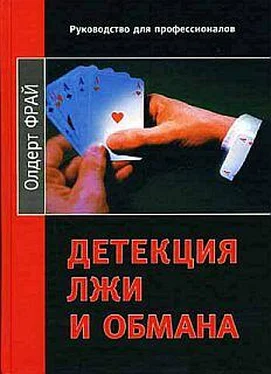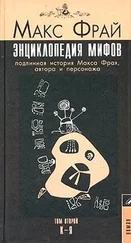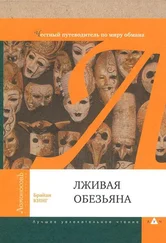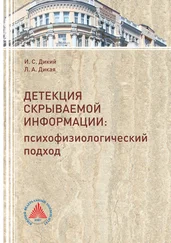Furedy, J. J. (1996b). The North American polygraph and psychophysiology: disinterested, uninterested, and interested perspectives. International Journal of Psychophysiology, 21, 91-105.
Furedy, J. J. & Heslegrave, R.J. (1988). Validity of the lie detector: a psychophysiological perspective. Criminal Justice and Behavior, 15, 219–246.
Gale, A. (1988). The polygraph test, more than scientific investigation. In A. Gale (Ed.), The polygraph test: lies, truth and science. London: Sage, 1–9.
Garratt, G. A., Baxter, J. C. & Rozelle, R. M. (1981). Training university police in black-American nonverbal behavior. Journal of Social Psychology , 113, 211–229.
Garrido, E., Masip, J., Herrero, C., Tabernero, С & Vega, M.T. (1998). Policemen's ability to discern truth from deception. Unpublished manuscript.
Ginton, A., Daie, N., Elaad, E. & Ben-Shakhar, G. (1982). A method for evaluating the use of the polygraph in a real-life situation. Journal of Applied Psychology, 61,131–131.
Goldman-Eisler, F. (1968). Psycholinguistics: experiments in spontaneous speech. New York: Doubleday.
Goodman, G. S. & Schwartz-Kenney (1992). Why knowing a child's age is not enough: influences of cognitive, social, and emotional factors on children's testimony. In H. Dent & R. Flin (Eds), Children as witnesses. Chichester: John Wiley, 15–32.
Goodman, G. S., Rudy, L., Bottoms, B. & Aman, C. (1990). Children's concerns and memory: issues of ecological validity in the study of children's eyewitness testimony. In R. Fivush & J. Hudson (Eds), Knowing and remembering in young children. New York: Cambridge University Press, 249–284.
Gordon, R.A., Baxter, J.C, Rozelle, R.M., & Druckman, D. (1981). Expectations of honest, evasive and deceptive nonverbal behavior. Journal of Social Psychology, 121,231–233.
Gordon, B. N., Schroeder, С. S. & Abrams, J. M. (1990). Age and social class differences in children's knowledge of sexuality.Journal of Clinical Child Psychology, 19,33–43.
Granhag, P.A. & Stromwall, L.A. (1998). «Let's go over this again»: effects of repeated interrogations on deception detection performance. Paper presented at the Eighth European Conference on Psychology and Law, Cracow, Poland, September 1998.
Greene, J.O., O'Hair, H.D., Cody, MJ. & Yen, С. (1985). Planning and control of behavior during deception. Human Communication Research, 11, 335–364.
Greuel, L. (1992). Police officers' beliefs about cues associated with deception in rape cases. In F. Losel, D. Bender & T Bliesener (Eds), Psychology and law: international perspectives. Berlin: Walter de Gruyter, 234–239.
Gudjonsson, G. H. (1992). The psychology of interrogations, confessions and testimony. Chichester: John Wiley.
Hale, J. L. & Stiff, J. B. (1990). Nonverbal primacy in veracity judgments. Communication Reports, 3, 15–83.
Hall, J. A. (1919). Gender effects in decoding nonverbal cues. Psychological Bulletin, 85,845–851.
Hall, J. A. (1984). Nonverbal sex differences: communication accuracy and expressive style. Baltimore, MD: The Johns Hopkins University Press.
Hemsley, G. D. & Doob, A. N. (1918). The effect of looking behavior on perceptions of a communicator's credibility. Journal of Applied Social Psychology, 8,136–144.
Hernandez-Fernaud, E. & Alonso-Quecuty, M. (1991). The cognitive interview and lie detection: a new magnifying glass for Sherlock Holmes? Applied Cognitive Psychology , 11, 55–68.
Hershkowitz, I., Lamb, M. E., Sternberg, K. J. & Esplin, P.W. (1991). The relationships among interviewer utterance type, CBCA scores and the richness of children's responses. Legal and Criminological Psychology, 2, 169–116.
Hocking, J. E. & Leathers, D. G. (1980). Nonverbal indicators of deception: a new theoretical perspective. Communication Monographs. 41,119–131.
Hrfer, E. & Kohnken, G. (1999) Assessingthe credibility of witness statements. Paper presented at the Ninth European Conference on Psychology and Law, Dublin, Ireland, July 1999.
Hrfer, E., Akehurst, L. & Metzger, G. (1996). Reality monitoring: a chance for further development of CBCA? Paper presented at the Annual Meeting of the European Association on Psychology and Law in Sienna, Italy, August 1996.
Hrfer, E., Kohnken, G., Hanewinkel, R. & Bruhn, C. (1993) . Diagnostik and attribution vonglaubwiirdigkeit. Kiel: Final report to the Deutsche Forschungsgemeinschaft, КО 882/4-2 Kiel, Germany: University of Kiel.
Honts, C. R. (1991). The emperor's new clothes: the application of the polygraph tests in the American workplace. Forensic Reports, 4,91-116.
Honts, С. R. (1994). Assessing children's credibility: scientific and legal issues in 1994. North Dakota Law Review, 10, 819–903.
Honts, C. R. (1995). The polygraph in 1995: progress in science and the law. North Dakota Law Review, 11, 981-1020.
Honts, С. R. (1996). Criterion development and validity of the TKB in field application. Journal of General Psychology , 123, 309–324.
Honts, C.R. & Perry, M.V. (1992). Polygraph admissibility: changes and challenges. Law and Human Behavior, 16, 351–319.
Honts, С R. & Raskin, D. С. (1988). A field study of the validity of the directed lie control question. Journal of Police Science and Administration, 16, 56–61.
Honts, С R., Devitt, M. K, Winbush, M. & Kircher J. С. (1996). Mental and physical countermeasures reduce the accuracy of the concealed knowledge test. Psychophysiology, 33,84–92.
Honts, C. R., Modes, R. L. & Raskin, В. С. (1985). Effects of physical counter-measures on the physiological detection of deception. Journal of Applied Psychology, 10,111–181.
Honts, C. R., Kircher, J. C. & Raskin, В. С. (1996). Polygrapher's dilemma or psychologist's: a reply to Furedy's logico-ethical considerations for psychophysiological practitioners and researchers. International Journal of Psychophysiology, 20, 199–201.
Honts, С R., Raskin, В. С & Kircher, J. С. (1981). Effects of physical counter-measures and their electromyographic detection during polygraph tests for deception. Journal of Psychophysiology, 1, 241241.
Honts, C. R., Raskin, В. С & Kircher, J. С. (1994). Mental and physical counter-measures reduce the accuracy of polygraph tests. Journal of Applied Psychology, 19,252–259.
Honts, C.R., Raskin, B.C., Kircher, J. С & Hodes, R. L. (1988). Effects of spontaneous countermeasures on the physiological detection of deception. JoMrrca/ of Police Science and Administration, 16, 9194. л
Horowitz, S. W. (1991). Empirical support for statement validity assessment. Behavioral Assessment, 13, 293–313.
Читать дальше











